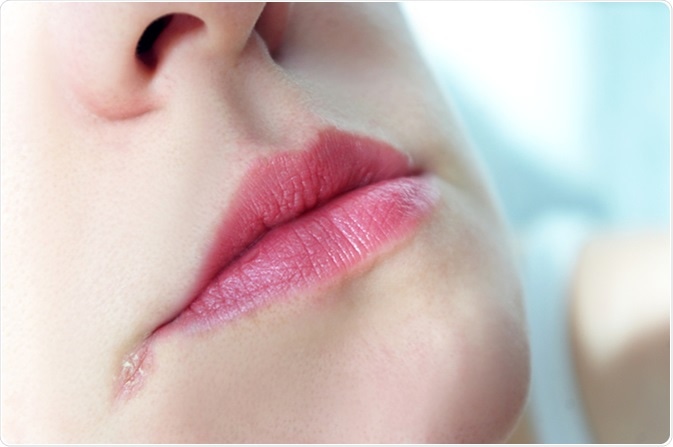
Actinic Cheilitis Prevention
Sailor’s lip, farmer’s lip or actinic cheilitis (AC) are the terms used to describe the condition of damaged lips, particularly the vermilion border of the lip, by a cumulative exposure to the sun. Lips of people with this condition look dry, cracked, or chapped. The lips also present with lesions or ulcers. The sharp vermilion border becomes blurred.
Although it occurs in the upper lip, the lower lip is the most commonly affected area.It is more likely to arise in men than women (mostly Caucasians). Biopsy is one of the diagnoses that confirm this disease and people have different types of treatments based on the severity of the condition.

Image Credit: Cessna152 / Shutterstock
Why Prevention?
Living with AC is extremely difficult. The people affected with this condition experience constant irritation in the skin, which creates discomfort. There is a chance for bacterial or fungal infection as the lesions in the lip may bleed and develop ulcers.
Sometimes, permanent cicatrix may occur in the case of actinic keratosis. One of the major complications that can be developed due to AC is squamous cell carcinoma — a type of skin cancer that usually takes place due to delay in treatment or when the condition remains untreated.
Prevention is better than cure so to safeguard from this chronic and premalignant condition and the resultant complications, people need to take preventive measures.
Preventive Methods
The best prevention is to avoid prolonged and chronic sun exposure. If you cannot stay away from sun due to your profession, then implement some alternative methods such as using wide-brimmed hats and protective clothing when the intensity of sun exposure is the maximum.
Use of sunscreens such as lip balms having high sun-protection factor and preventing actinic keratosis also help in preventing AC. Frequent diagnosis by a physician should be done when an individual is regularly exposed to the sun or work in a sunny atmosphere.
Avoiding Sun Exposure
Spending time in the sun increases the risk of skin cancer and premature skin aging. Persons of white skin color are mostly affected by invisible ultraviolet (UV) radiations, particularly ultraviolet A & B (UVA & UVB). When the skin cells are damaged by UV rays, it affects the growth of skin cells and leads to skin cancers and conditions like AC.
The skin cells can be protected from radiation of the sun exposure by following the below practices:
- Avoid excessive sunbathing and roaming outside during spring and summer months, since the intensity of the UV rays are stronger then.
- Avoid staying out in the sun or limit it,especially between 10 a.m. to 2 p.m., when the sun’s radiations are at peak.
Use of Sunscreen
Normally, FDA suggests that broad-spectrum sunscreens such as lip balm having a sun protection factor (SPF) of 15 or higher can help in prevention from UVB rays, although for cloudy days there are different sunscreens available in the form of lotions, creams, sticks, gels, and sprays.
These sunscreens should be applied properly on uncovered skin especially that of the nose, hands, and lips at least every two hours. The sunscreen will not completely block UV radiation but it will reduce the risk of getting affected.
In general, the sunscreen balms last for some minutes. No sunscreen is waterproof, so during swimming or sweating, a balm with a high level of SPF needs to be applied, which has a lasting period of roughly 40 minutes. This will prevent the lips from drying and will also protect, moisturize and soothe them.
Check Immunosuppression
It is necessary to understand the primary importance of UV radiation mechanisms that affect the immune system. The UV radiation induces varied biological effects such as premature skin aging, and can inhibit or suppress the skin’s immune system, which may involve in skin cancer.
In many ways, UV radiation can suppress the immune system. The radiation stimulates the release of immunosuppressive cytokines, induces generation of lymphocytes of the regulatory subtype, and inhibits antigen presentation.
The major target source, where the immunosuppression takes place, is in the DNA molecule. More clarification on UV-induced immunosuppression will pave the way not only for better understanding of the effects of UV radiation, but also to frame new protective strategies.
Preventing Actinic Keratosis
Actinic keratosis or solar keratosis which is also caused by excess sun exposure can lead to AC. A well-known chemical compound called retinoid, which includes tretinoin, isotretinoin, retinaldehyde, etc., is broadly used for preventing non-melanoma skin cancers, especially actinic keratosis (AK). However, the effectiveness of these drugs has proved to inhibit the development of new precancerous skin lesions and skin cancers.
These retinoids have anti-proliferative and anti-apoptotic properties, which regulate the growth of keratinocytes. They increase the expression of p53 and act as an antioxidant to reduce the number of sunburn cells.
Sources
- https://www.ncbi.nlm.nih.gov/pubmed/16117738
- https://www.ncbi.nlm.nih.gov/pmc/articles/PMC3760934/
- http://www.oooojournal.net/article/S2212-4403(16)30443-6/abstract
- https://www.fda.gov/ForConsumers/ConsumerUpdates/ucm049090.htm
- www.guident.net/.../...remalignant-condition-review-of-literature.html
- www.cancer.org/.../what-is-uv-radiation.html
- https://www.ncbi.nlm.nih.gov/pubmed/18410801
- www.mayoclinic.org/.../art-20045110
Further Reading
Last Updated: Aug 23, 2018






















.png)










No hay comentarios:
Publicar un comentario